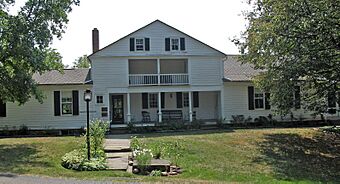Spring Hill Historic Home facts for kids
Spring Hill is a special historic house in Massillon, Ohio. It's now a museum where you can learn about its past. A family named Rotch first built this home, and later the Wales family lived there for many years. Spring Hill is famous because it was a safe place on the Underground Railroad, helping people escape slavery. The property includes the main house and several smaller buildings, like a smokehouse and a wool house.
Contents
Discovering Spring Hill's History
How Spring Hill Began
Thomas and Charity Rotch were a couple from New Bedford, Massachusetts. In January 1811, they traveled west looking for a new place to live. Charity Rotch was often sick, and they hoped a milder climate would help her feel better.
Thomas Rotch was a Quaker and worked with wool. He needed a place where his sheep could graze easily. He also needed a spot where wool could be transported without trouble. They met friendly Quakers in Steubenville, Ohio, who told them good things about the area near Sippo Creek.
Thomas decided to move his family there because of the fresh water and clear land. On their journey, Thomas Rotch met Arvine Wales. Arvine became a close friend and later bought Spring Hill after Thomas and Charity passed away. The Wales family lived at Spring Hill until 1966. After that, the estate became a museum.
Founding the Town of Kendal
When the Rotches settled, they started building their home and named the area Kendal. They named it after a textile center in England. Thomas Rotch designed streets and squares, making it look like a New England town. Many early settlers in Kendal were also Quakers.
The town was officially founded on April 20, 1812. By 1817, Kendal was growing, with over 100 plots of land settled. Since most people in Kendal were Quakers, they strongly believed in ending slavery. Routes and safe stops for the Underground Railroad were set up in Kendal as early as 1817. From 1821 to 1865, no enslaved people hiding at Spring Hill were ever caught.
Building the Spring Hill Home
The main house at Spring Hill was built between 1821 and 1824. The architect, Jehial Fox, designed the house to be 80 feet long. He used different materials like stone, brick, and large oak planks. Some of these oak pieces were as long as 28 feet!
The house first had a special stove called a Franklin stove. In 1831, Arvine Wales changed this stove into a fireplace. Arvine Wales made most of the updates to the original house. He added a western wing to the house. The Wales family also added a small bathroom upstairs.
They created another bathroom downstairs by adding a wall to the parlor. They also changed the kitchen and dining room walls. This created a breakfast room and a kitchen on the first floor. Originally, the kitchen was in the basement. Food was moved up and down using a dumbwaiter, which is like a small elevator. This dumbwaiter was later removed. In 1920, a screened-in porch was added to the western wing. This was the last big change to Spring Hill while a family lived there.
The Secret Staircase
The Spring Hill home is well-known for its secret staircase. This special feature helped enslaved people using the Underground Railroad pass through safely. Architect Jehial Fox placed this staircase in the middle of the house. It was probably first meant for the house staff to use.
However, once the kitchen moved, the staff no longer needed the staircase. Instead, it became a hiding place for runaway enslaved people as early as 1821. They would use this staircase to go down to the basement. There, they could hide safely before continuing their journey to freedom.
After Thomas Rotch passed away in 1823 and Charity Rotch in 1824, the Wales family continued to help and protect enslaved people seeking freedom.
Important Outbuildings
Spring Hill was built to be a working farm and home. Many service buildings were constructed on the property to help with daily tasks. Many of these buildings have been fixed up and can still be seen today.
These service buildings include a carriage house, a smokehouse, a dog kennel, a spring house, a milk house, a grain barn, and a wool house. The carriage house is one of the larger buildings. It has a room above it where farmhands could stay while working at Spring Hill. All these buildings helped support Spring Hill and the nearby Kendal community.




